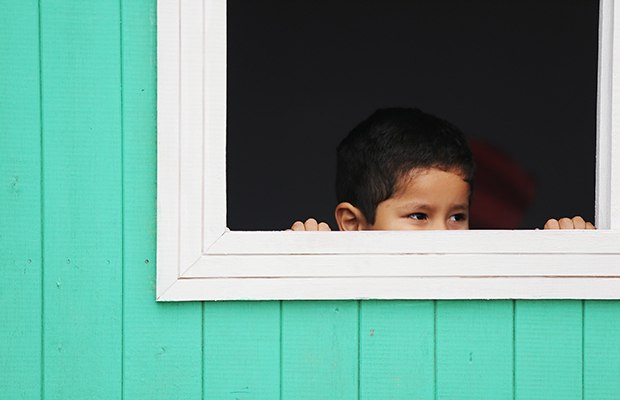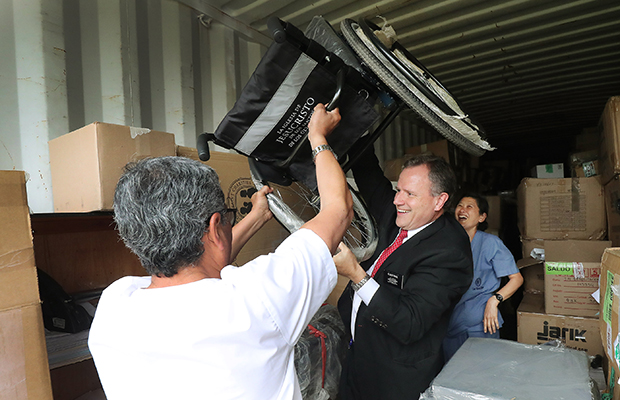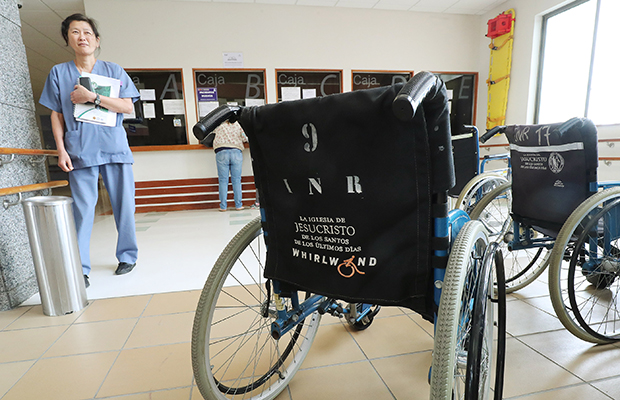90-Year-Old Prophecy Continues to Be Fulfilled with Upcoming Dedication of the 19th Temple in South America
Contributed By Sarah Jane Weaver, Church News editor

Sister missionaries smile after meeting with President Russell M. Nelson of The Church of Jesus Christ of Latter-day Saints in Lima, Peru, on October 20, 2018.
Article Highlights
- Latter-day Saints in South America have become a power in the Church, as Elder Melvin J. Ballard prophesied in 1926.
- The work of early members made possible the Church’s growth in South America.
- The best is yet to come, says President Nelson.
“The best is yet ahead. We are just looking at the beginning now.” —President Russell M. Nelson
Related Links
In 1925, three leaders of The Church of Jesus Christ of Latter-day Saints—Elder Melvin J. Ballard, Elder Rey L. Pratt, and Elder Rulon S. Wells—embarked on a 34-day journey, by land and sea, from Salt Lake City to Buenos Aires, Argentina.
Of the trip, President M. Russell Ballard, Acting President of the Quorum of the Twelve Apostles and the grandson of Elder Melvin J. Ballard, said: “My grandfather went out into the streets of Argentina. They did not have a great harvest. They did not see the people flock into the Church by any means.”
Instead, they found an apartment to rent and went to work.
On Christmas Day of 1925, in the park of Tres de Febrero in Buenos Aires, Argentina, Elder Melvin J. Ballard dedicated South America for the preaching of the gospel.
“Bless the presidents, governors, and the leading officials of these South American countries, that they may kindly receive us and give us permission to open the doors of salvation to the people of these lands,” he prayed.
Early in the mission, Elder Wells became ill and had to return to Salt Lake City. Elder Ballard and Elder Pratt remained, walking the streets of Buenos Aires passing out handbills about the Restoration of the gospel; their efforts resulted in a single conversion.
Then on July 4, 1926, as Elder Ballard was preparing to return to Utah, he spoke about the future of the Church in South America. From his office in Salt Lake City, President Ballard read his grandfather’s prophecy: “The work of the Lord will grow slowly for a time here just as an oak grows slowly from an acorn. It will not shoot up in a day as does the sunflower that grows quickly and then dies. But thousands will join the Church here. It will be divided into more than one mission and will be one of the strongest in the Church. … The South American Mission will be a power in the Church.”
During a recent visit to South America, President Russell M. Nelson spoke of the early missionaries, who “didn’t feel very successful. In fact, they finished their visit here feeling rather down that they didn’t get much done.” And President Nelson spoke of the Church today in South America. “It is not just numbers; it is strength, it is power, it is faith,” said President Nelson.
“A power in the Church”
Indeed, more than nine decades since that inspired prophecy, South America is a power in the Church. Latter-day Saint membership on the continent numbers 4,076,054, with 692 stakes, 4,178 wards, 95 missions, and 18 operating temples, according to Church statistics. Since 1970, more than 187,000 missionaries have served in South America.
At the time of the historic dedicatory prayer, President Nelson was 15 months old.
“The Church is relatively young here in South America,” said President Nelson. “Ninety years ago, nothing. … And now … we saw four-generation families.”
One of those families is Eduardo and Jeanet Echevarria Risso. “Our posterity is our most important thing,” said Eduardo Risso. “It is our joy.”
The family, who came into the Church in 1973, has a tradition of missionary work. “We are so proud of our children,” said Risso, noting their first goal for their posterity was Church activity.
The journey to 19 temples
Another example of the growth of the Church in South America is Nestor Curbelo. After three years of working with the missionaries, he was baptized in 1969. On the day of his baptism, he paid the tithing he had been saving for more than one year.
Back then, without a temple in South America, he was told to “get baptized, be faithful, and attend church.”
Missionaries became a symbol of the Church in early days in Uruguay.
Early in their marriage, Curbelo’s wife, Rosalina Coitino, thought of the temple as “something she would do in the millennium.”
But “the Church started growing little by little. We started learning about the temple little by little.”
The 1978 dedication of the São Paulo Brazil Temple—the 17th in the Church and the first in South America—changed everything for the Curbelos and the other members. Many members sacrificed for the temple, selling military medals of honor or the gold from their teeth, said Curbelo. “Families sold their TV or their car or their bicycle. They did this to build the temple or to travel to the temple.
“The São Paulo Temple was the temple of South America,” he said. “All the converts who joined the Church from the beginning to 1978 had the blessing of the temple.”
Forty years later, the Barranquilla Colombia Temple, scheduled for dedication on December 9, will become the 19th temple in South America.
“I saw the Church with just a few members when I got baptized,” Curbelo said. “Now there are thousands and thousands.”
The work of early members
In 1960, when missionaries arrived in Talcahuano, Chile, the Church was not yet organized in the area. They prayed and were directed to Alberto Altamirano’s home. Alberto’s parents, José and Luz, listened to the message. They believed the missionaries to be men of God.
The missionaries carried an artist’s depiction of the Savior. Soon Alberto’s mother—followed a few months later by his father—entered the waters of baptism in San Pedro Lake.
José Altamirano became the first branch president, and then district president, in Talcahuano. When the Talcahuano Stake was created in 1977, he became the first stake president.
Seeing the new temple in Concepción would make his parents very happy, said Altamirano of the Talcahuano Chile North Stake. “They worked so hard at the beginning of the Church here. [A temple] here is the culmination of all their work.”
A prophecy fulfilled
Elder Melvin J. Ballard’s prophecy is becoming a reality, said Alfredo Salas, director of public affairs in the Church’s South America South Area.
“I still feel like there is more to come,” he said. “A few years ago, we only had a few temples. Now we have two, three, or four temples in some countries.”
Secundino Delgado joined the Church in Peru 50 years ago. One of 40 baptisms performed on Christmas Day a half century ago, Delgado’s baptism was dubbed a “white Christmas” by missionaries.
“It has been a miracle how the Church has grown,” said Delgado. “We were one stake; now we are hundreds of stakes. It has been amazing to be part of that.”
The Delgados and other second, third, and fourth generations of Latter-day Saint families “are becoming a strength in the Church and hopefully in the world,” said Salas.
Having temples close to the people is a wonderful blessing, he said.
During his October visit to the South American nations of Peru, Bolivia, Paraguay, Uruguay, and Chile, President Nelson spoke to thousands gathered for member meetings. During each meeting he addressed the members in Spanish and spoke of the miracle unfolding before them in South America and across the world.
“And the best is yet ahead,” said President Nelson in Paraguay. “We are just looking at the beginning now.”
Days later he elaborated during an interview in Chile. “We’re witnesses to a process of restoration,” said President Nelson. “If you think the Church has been fully restored, you’re just seeing the beginning. There is much more to come. … Wait till next year. And then the next year. Eat your vitamin pills. Get your rest. It’s going to be exciting.”

Students at the Heart of Jesus Preschool sing a song in Lima, Peru, on Friday, October 19, 2018. LDS Charities donated three prefabricated classrooms, including tables and chairs and other school supplies. Photo by Jeffrey D. Allred, Deseret News.

A student peers out of a window of a prefabricated classroom at Heart of Jesus Preschool in Lima, Peru, on Friday, October 19, 2018. LDS Charities donated three classrooms, including tables and chairs and other school supplies. Photo by Jeffrey D. Allred, Deseret News.

Valentine Alfredo walks with her daughters to the Heart of Jesus Preschool in Lima, Peru, on Friday, October 19, 2018. Photo by Jeffrey D. Allred, Deseret News.

Students sit at a donated table at the Heart of Jesus Preschool in Lima, Peru, on Friday, October 19, 2018. Photo by Jeffrey D. Allred, Deseret News.

Elder Floyd Rose helps Dr. Urcia Fernando unload a Church-donated wheelchair at the Institute of National Rehabilitation in Lima, Peru, on Friday, October 19, 2018. LDS Charities has donated 6,200 wheelchairs. Photo by Jeffrey D. Allred, Deseret News.

Physical therapist Diana Cam Chiock looks over a donated wheelchair at the Institute of National Rehabilitation in Lima, Peru, on Friday, October 19, 2018. LDS Charities has donated 6,200 wheelchairs to the center. Photo by Jeffrey D. Allred, Deseret News.

Motorists travel along the coastal highway in Lima, Peru, on Friday, October 19, 2018. Photo by Jeffrey D. Allred, Deseret News.

Housing lines the hillside in Lima, Peru, on Friday, October 19, 2018. Photo by Jeffrey D. Allred, Deseret News.

Churros are sold at Plaza Mayor in downtown Lima, Peru, on October 21, 2018. Photo by Jeffrey D. Allred, Deseret News.

Blind individuals applaud during a delivery ceremony at The Church of Jesus Christ of Latter-day Saints Las Brisas Ward in Lima, Peru, on Friday, October 19, 2018. LDS Charities donated 1,150 canes and 1,150 braille readers. Photo by Jeffrey D. Allred, Deseret News.
